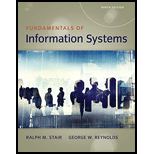
Concept explainers
Mention some examples of waste and mistakes in an IS environment along with their causes, and recommended solutions.
Explanation of Solution
The major cause of computer related problems is the computer-related waste and mistakes. Let us see some examples of these waste and mistakes one by one including their causes and possible solutions.
Computer-related waste
Some of the computer-related waste are as follows:
Operating unintegrated information systems: Some organizations for cost-benefit operate with unintegrated information systems which results in a difficulty in collaborating and sharing information among decision makers and further leads to missingupcomingopportunities, extra cost, and less sales.
Acquiring redundant systems: Unknowingly some organizations acquire those information systems which otherwise looks different as per their specification but performs same tasks as are performed by already installed systems in the company. These issues often occur due to improper analyses of requirements before investing into these systems. Acquiring redundant system increases company’s hardware and software cost.
Wasting information systems resources: In some companies there are no proper guidelines for employeesregarding the proper usage of
Computer-related mistakes
Computer related mistakes are errors, failure, and other computer problems which result in incorrect output. Some of the common computer-related mistakes are as follows:
- Data-entry or data capture errors.
Programming errors.- Errors in file handling.
- Mishandling computer output
- Installing inadequate computing capacity than required
- Failure to provide access to most current information.
Possible solutions to computer-related waste and mistakes
To prevent such computer-related waste and mistakes, employees and managers should work together to minimize waste and organizations should make its efforts towards establishing, implementing, monitoring, and reviewing effective policies and procedures.
The organization should establish policies and procedure regarding acquisition, use and disposal of information system resources. Once the policies are decided, they should implement these policies with a proper training so that users are aware of how to use the information resources. After the implementation, the organization should keep watch on whether the policies and procedures are being followed and take necessary actions incase of negligence. Finally, the company should review the already formed guidelines to check whether they are performing the intended task.
Want to see more full solutions like this?
Chapter 10 Solutions
Fundamentals of Information Systems
- Answer this JAVA OOP question below: An Employee has a name, employee ID, and department. An Employee object must be created with all its attributes. The UML diagram is provided below: - name: String - employeeId: String - department: String + Employee(name: String, employeeId: String, department: String) + setName(name: String): void + setEmployeeId(employeeId: String): void + setDepartment(department: String): void + getName(): String + getEmployeeId(): String + getDepartment(): String + toString(): String A faculty is an Employee with an additional field String field: rank public class TestImplementation{ public static void main(String[] args){ Employee[] allEmployee = new Employee[100]; // create an employee object with name Tom Evan, employee ID 001 and department IST and store it in allEmployee // create a faculty object with name Adam Scott, employee ID 002, department IST and rank Professor and store it in allEmployee } }arrow_forwardPlease answer this JAVA OOP question that is given below: An Employee has a name, employee ID, and department. An Employee object must be created with all its attributes. The UML diagram is provided below: - name: String - employeeId: String - department: String + Employee(name: String, employeeId: String, department: String) + setName(name: String): void + setEmployeeId(employeeId: String): void + setDepartment(department: String): void + getName(): String + getEmployeeId(): String + getDepartment(): String + toString(): String A faculty is an Employee with an additional field String field: rank Assuming the Employee class is fully implemented, define a Professor class in Java with the following: A toString() method that includes both the inherited attributes and the specializationarrow_forwardPlease answer JAVA OOP question below: An Employee has a name, employee ID, and department. An Employee object must be created with all its attributes. The UML diagram is provided below: - name: String - employeeId: String - department: String + Employee(name: String, employeeId: String, department: String) + setName(name: String): void + setEmployeeId(employeeId: String): void + setDepartment(department: String): void + getName(): String + getEmployeeId(): String + getDepartment(): String + toString(): String A faculty is an Employee with an additional field String field: rank Assuming the Employee class is fully implemented, define a Professor class in Java with the following: Instance variable(s) A Constructorarrow_forward
- Develop a C++ program that execute the operation as stated by TM for addition of two binary numbers (see attached image). Your code should receive two binary numbers and output the resulting sum (also in binary). Make sure your code mimics the TM operations (dealing with the binary numbers as a string of characters 1 and 0, and following the logic to increase the first number and decreasing the second one. Try your TM for the following examples: 1101 and 101, resulting 10010; and 1101 and 11, resulting 10000.arrow_forwardI need to define and discuss the uses of one monitoring or troubleshooting tool in Windows Server 2019. thank youarrow_forwardI would likr toget help with the following concepts: - Windows Server features - Windows Server versus Windows 10 used as a client-server networkarrow_forward
 Enhanced Discovering Computers 2017 (Shelly Cashm...Computer ScienceISBN:9781305657458Author:Misty E. Vermaat, Susan L. Sebok, Steven M. Freund, Mark Frydenberg, Jennifer T. CampbellPublisher:Cengage Learning
Enhanced Discovering Computers 2017 (Shelly Cashm...Computer ScienceISBN:9781305657458Author:Misty E. Vermaat, Susan L. Sebok, Steven M. Freund, Mark Frydenberg, Jennifer T. CampbellPublisher:Cengage Learning Principles of Information Systems (MindTap Course...Computer ScienceISBN:9781305971776Author:Ralph Stair, George ReynoldsPublisher:Cengage Learning
Principles of Information Systems (MindTap Course...Computer ScienceISBN:9781305971776Author:Ralph Stair, George ReynoldsPublisher:Cengage Learning Management Of Information SecurityComputer ScienceISBN:9781337405713Author:WHITMAN, Michael.Publisher:Cengage Learning,
Management Of Information SecurityComputer ScienceISBN:9781337405713Author:WHITMAN, Michael.Publisher:Cengage Learning, Fundamentals of Information SystemsComputer ScienceISBN:9781337097536Author:Ralph Stair, George ReynoldsPublisher:Cengage Learning
Fundamentals of Information SystemsComputer ScienceISBN:9781337097536Author:Ralph Stair, George ReynoldsPublisher:Cengage Learning Principles of Information Systems (MindTap Course...Computer ScienceISBN:9781285867168Author:Ralph Stair, George ReynoldsPublisher:Cengage Learning
Principles of Information Systems (MindTap Course...Computer ScienceISBN:9781285867168Author:Ralph Stair, George ReynoldsPublisher:Cengage Learning





